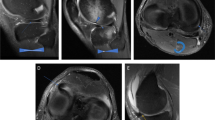Abstract
Objective
Gluteal tendinopathy and greater trochanteric pain syndrome (GTPS) remain incompletely understood despite their pervasiveness in clinical practice. To date, no study has analyzed the morphometric characteristics of the hip on magnetic resonance imaging (MRI) that may predispose to gluteal tendinopathy. This study aimed to evaluate whether acetabular anteversion (AA), femoral neck anteversion (FNA), and femoral neck-shaft angle (FNSA) are associated with MRI features of gluteal tendinopathy.
Materials and methods
A total of 203 MRI examinations of the hip met our inclusion and exclusion criteria. A single blinded investigator measured AA, FNA, and FNSA according to validated MRI techniques. Two blinded subspecialty-trained musculoskeletal radiologists then independently evaluated the presence of gluteal tendinosis, trochanteric bursitis, and subgluteal bursitis. Statistical analysis was performed using a one-way analysis of variance (ANOVA; post-hoc Tukey’s range test).
Results
At MRI, 57 patients had gluteal tendinosis with or without bursitis, 26 had isolated trochanteric bursitis, and 11 had isolated subgluteal bursitis. AA was significantly (p = 0.01) increased in patients with MRI evidence of gluteal tendinosis with or without bursitis [mean: 18.4°, 95 % confidence interval (CI): 17.2°-19.6°] compared with normal controls (mean: 15.7°, 95 % CI: 14.7°-16.8°). Similarly, AA was significantly (p = 0.04) increased in patients with isolated trochanteric bursitis (mean: 18.8°, 95 % CI: 16.2°-21.6°). No association was found between FNA or FNSA and the presence of gluteal tendinopathy. Interobserver agreement for the presence and categorization of gluteal tendinopathy was very good (kappa = 0.859, 95 % CI: 0.815-0.903).
Conclusion
Our MRI study suggests that there is an association between increased AA and gluteal tendinopathy, which supports a growing body of evidence implicating abnormal biomechanics in the development of this condition.





Similar content being viewed by others
References
Kingzett-Taylor A, Tirman PF, Feller J, McGann W, Prieto V, Wischer T, et al. Tendinosis and tears of gluteus medius and minimus muscles as a cause of hip pain: MR imaging findings. AJR Am J Roentgenol. 1999;173(4):1123–6.
Dwek J, Pfirrmann C, Stanley A, Pathria M, Chung CB. MR imaging of the hip abductors: normal anatomy and commonly encountered pathology at the greater trochanter. Magn Reson Imaging Clin N Am. 2005;13(4):691–704. vii.
McMahon SE, Smith TO, Hing CB. A systematic review of imaging modalities in the diagnosis of greater trochanteric pain syndrome. Musculoskelet Care. 2012;10(4):232–9.
Segal NA, Felson DT, Torner JC, Zhu Y, Curtis JR, Niu J, et al. Greater trochanteric pain syndrome: epidemiology and associated factors. Arch Phys Med Rehabil. 2007;88(8):988–92.
Furia JP, Rompe JD, Maffulli N. Low-energy extracorporeal shock wave therapy as a treatment for greater trochanteric pain syndrome. Am J Sports Med. 2009;37(9):1806–13.
Klauser AS, Martinoli C, Tagliafico A, Bellmann-Weiler R, Feuchtner GM, Wick M, et al. Greater trochanteric pain syndrome. Semin Musculoskelet Radiol. 2013;17(1):43–8.
Rompe JD, Segal NA, Cacchio A, Furia JP, Morral A, Maffulli N. Home training, local corticosteroid injection, or radial shock wave therapy for greater trochanter pain syndrome. Am J Sports Med. 2009;37(10):1981–90.
Fearon A, Stephens S, Cook J, Smith P, Neeman T, Cormick W, et al. The relationship of femoral neck shaft angle and adiposity to greater trochanteric pain syndrome in women. A case control morphology and anthropometric study. Br J Sports Med. 2012;46(12):888–92.
Tetreault P, Krueger A, Zurakowski D, Gerber C. Glenoid version and rotator cuff tears. J Orthop Res. 2004;22(1):202–7.
Fearon AM, Scarvell JM, Neeman T, Cook JL, Cormick W, Smith PN. Greater trochanteric pain syndrome: defining the clinical syndrome. Br J Sports Med. 2013;47(10):649–53.
Tonnis D, Heinecke A. Acetabular and femoral anteversion: relationship with osteoarthritis of the hip. J Bone Joint Surg Am. 1999;81(12):1747–70.
Muhamad AR, Freitas JM, Bomar JD, Hosalkar H. Acetabular version on magnetic resonance imaging: analysis of two different measuring techniques. Hip Int. 2012;22(6):672–6.
Shon WY, Yun HH, Yang JH, Song SY, Park SB, Lee JW. The use of the posterior lesser trochanter line to estimate femoral neck version: an analysis of computed tomography measurements. J Arthroplasty. 2013;28(2):352–8.
Botser IB, Ozoude GC, Martin DE, Siddiqi AJ, Kuppuswami S, Domb BG. Femoral anteversion in the hip: comparison of measurement by computed tomography, magnetic resonance imaging, and physical examination. Arthroscopy. 2012;28(5):619–27.
Aly AR, Rajasekaran S, Obaid H. MRI morphometric hip comparison analysis of anterior acetabular labral tears. Skelet Radiol. 2013;42(12):1751–4.
Beall DP, Martin HD, Mintz DN, Ly JQ, Costello RF, Braly BA, et al. Anatomic and structural evaluation of the hip: a cross-sectional imaging technique combining anatomic and biomechanical evaluations. Clin Imaging. 2008;32(5):372–81.
Segal NA, Harvey W, Felson DT, Yang M, Torner JC, Curtis JR, et al. Leg-length inequality is not associated with greater trochanteric pain syndrome. Arthritis Res Ther. 2008;10(3):R62.
Neer 2nd CS. Anterior acromioplasty for the chronic impingement syndrome in the shoulder: a preliminary report. J Bone Joint Surg Am. 1972;54(1):41–50.
Hughes RE, Bryant CR, Hall JM, Wening J, Huston LJ, Kuhn JE, et al. Glenoid inclination is associated with full-thickness rotator cuff tears. Clin Orthop Relat Res. 2003;407:86–91.
Tokgoz N, Kanatli U, Voyvoda NK, Gultekin S, Bolukbasi S, Tali ET. The relationship of glenoid and humeral version with supraspinatus tendon tears. Skelet Radiol. 2007;36(6):509–14.
Blank E, Owens BD, Burks R, Belmont Jr PJ. Incidence of greater trochanteric pain syndrome in active duty US military servicemembers. Orthopedics. 2012;35(7):e1022–7.
Karpinski MR, Piggott H. Greater trochanteric pain syndrome. A report of 15 cases. J Bone Joint Surg (Br). 1985;67(5):762–3.
Anderson K, Strickland SM, Warren R. Hip and groin injuries in athletes. Am J Sports Med. 2001;29(4):521–33.
Disclosures
The authors declare that they have no conflict of interest.
Author information
Authors and Affiliations
Corresponding author
Rights and permissions
About this article
Cite this article
Moulton, K.M., Aly, AR., Rajasekaran, S. et al. Acetabular anteversion is associated with gluteal tendinopathy at MRI. Skeletal Radiol 44, 47–54 (2015). https://doi.org/10.1007/s00256-014-1991-6
Received:
Revised:
Accepted:
Published:
Issue Date:
DOI: https://doi.org/10.1007/s00256-014-1991-6




